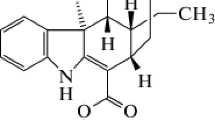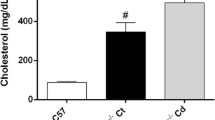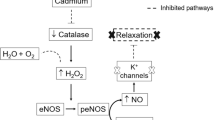Abstract
Apocynin is reported to have antioxidant and NADPH oxidase inhibitor activities. Cadmium toxicity is reported to causes oxidative damage, resulting in vascular dysfunction, reduced bioavailability of nitric oxide (NO) and hypertension. The study aimed to investigate the protective effects of apocynin in cadmium-induced hypertension. Thirty-six (36) adult male Sprague–Dawley rats were randomly divided into 6 groups. Group 1 served as control, Groups 2 and 3 received 50 and 100 mg/Kg (b.w) apocynin, respectively, Group 4 received 100 ppm CdCl2 in their drinking water, while Group 5 and 6 received 100 ppm CdCl2 in their drinking and 50 and 100 mg/Kg (b.w) apocynin, respectively, for 8 weeks. Blood pressure readings were taken weekly using the tail-cuff method. cGMP, endothelial nitric oxide synthase (eNOS), NO and hematological parameters were analyzed at the end of 8 weeks. Apocynin, although a poor antioxidant, caused a significant reduction (p < 0.05) in systolic and mean arterial pressures in the cadmium-induced elevations in blood pressure and amelioration of altered hematological parameters. However, while cadmium exposures did not alter the cGMP, eNOS and nitrate concentrations in serum, apocynin reduced the cGMP and nitrite values while significantly elevating (p < 0.05) the eNOS concentrations and also improved the cadmium-induced anemia. Apocynin was effective in reducing cadmium-induced elevated blood pressures through elevation of eNOS. Inhibition of NADPH oxidase activity may be a useful strategy for prevention and treatment of cadmium-induced hypertension.




Similar content being viewed by others
References
Nwokocha, C. R., Owu, D. U., Ufearo, C. S., & Iwuala, M. O. E. (2011). Comparative study on the efficacy of Garcinia kola in reducing some heavy metal accumulation in liver of Wistar rats. Journal of Ethnopharmacology, 135, 488–491.
Nwokocha, C. R., Nwokocha, Magdalene I., Daniel, U., Owu, Chioma Ebe, Nwangwu, Ozioma, & Iwuala, Moses O. (2012). Comparative analysis on the effect of palm oil (Elaeis guineensis) in reducing cadmium and lead accumulation in liver of Wistar rats. Pharmacognosy research, 4, 214–218.
Nordberg, G. F., Jin, T., Wu, X., Lu, J., Chen, L., Lei, L., et al. (2009). Prevalence of kidney dysfunction in humans—relationship to cadmium dose, metallothionein, immunological and metabolic factors. Biochimie, 91, 1282–1285.
Varoni, M. V., Palomba, D., Gianorso, S., & Anania, V. (2003). Cadmium as an environmental factor of hypertension in animals: new perspectives on mechanisms. Veterinary Research Communications, 27, 807–810.
Navas-Acien, A., Selvin, E., Sharrett, A. R., Calderon-Aranda, E., Silbergeld, E., & Guallar, E. (2004). Lead, cadmium, smoking, and increased risk of peripheral arterial disease. Circulation, 109, 3196–3201.
Nwokocha, C. R., Owu, D. U., Nwokocha, M. I., Ufearo, C. S., & Iwuala, M. O. E. (2012). Comparative Study on the Hepatoprotection to Heavy Metals of Zingiber Officinale. Pharmacognosy research, 4, 208–213.
Balaraman, R., Gulati, O. D., Bhatt, J. D., Rathod, S. P., & Hemavathi, K. G. (1989). Cadmium-induced hypertension in rats. Pharmacology, 38, 226–234.
Nwokocha, C. R., Owu, D. U., Ufearo, C., Edidjana, E., Nwogbo, N., & Ekpo, U. (2011). Estimation of absorbed cadmium in tissues of male and female Albino rats through different routes of administration. Nigerian journal of physiological, 26, 097–101.
Donpunha, W., Kukongviriyapan, U., Sompamit, K., Pakdeechote, P., Kukongviriyapan, V., & Pannangpetch, P. (2011). Protective effect of ascorbic acid on cadmium- induced hypertension and vascular dysfunction in mice. BioMetals, 24, 105–115.
Nwokocha, C. R., Ajayi, I. O., Owu, D. U., & Ebeigbe, A. B. (2012). Experimental malaria; the in vitro and in vivo blood pressure paradox. Cardiovasc Journal Africa, 23, 98–102.
Liu, S., Ma, X., Gong, M., Shi, L., Lincoln, T., & Wang, S. (2007). Glucose down-regulation of cGMP-dependent protein kinase I expression in vascular smooth muscle cells involves NAD(P)H oxidase-derived reactive oxygen species. Free Radic. Biology and medicine, 42, 852–863.
Nwokocha, C. R., Nwokocha, Magdalene I., Aneto, Imaria, Obi, Joshua, Udekweleze, Damian C., Olatunde, Bukola, et al. (2012). Comparative analysis on the hepatoprotective effect of Lycopersicon esculentum (Tomato) on metal accumulation in Wistar rats. Food and Chemical Toxicology, 50, 2070–2073.
Nwokocha, C. R., Owu, D. U., Ufearo, C. S., & Iwuala, M. O. E. (2012). Comparative study on the efficacy of Allium sativum (garlic) in reducing some heavy metal accumulation in liver of Wistar rats. Food and Chemical Toxicology, 50, 222–226.
Stefanska, J., & Pawliczak, R. (2008). Apocynin: Molecular aptitudes. Mediators of Inflammation, 2008, 1–10. doi:10.1155/2008/106507.
Heumuller, S., Wind, S., Barbosa-Sicard, E., Schmidth, H. H. H. W., Busse, R., Schroder, K., et al. (2008). Apocynin is not an inhibitor of vascular NADPH oxidase but an antioxidant. Hypertension, 51, 211–217.
Ulker, S., Mckeown, P. P., & Bayraktutan, U. (2003). Vitamins reverse endothelial dysfunction through regulation of eNOS and NAD(P)H oxidase activities. Hypertension, 41, 534–539.
Hamilton, C. A., Brosnan, M. J., Al-Benna, S., Berg, G., & Dominiczak, A. F. (2002). NAD(P)H oxidase inhibition improves endothelial function in rat and human blood vessels. Hypertension, 40, 755–762.
Lasse`gue, B., & Clempus, R. E. (2003). Vascular NAD(P)H oxidases: specific features, expression, and regulation. American journal of physiology. Regulatory and comparative physiology, 285, R277–R297.
Eakin, D. J., Schroeder, L. A., Whanger, P. D., & Weswig, P. H. (1980). Cadmium and nickel influence on blood pressure, plasma renin, and tissue mineral concentrations. American Physiological Society—endocrinology and metabolism, 238, E53–E61.
Staessen, J., Amery, A., Bernard, A., Bruaux, P., Buchet, J. P., Bulpitt, C. J., et al. (1991). Blood pressure, the prevalence of cardiovascular diseases, and exposure to cadmium: A population study. American journal of Epidemiology, 134, 257–267.
Yoopan, N., Watcharasit, P., Wongsawatkul, O., Piyachaturawat, P., & Satayavivad, J. (2008). Attenuation of eNOS expression in cadmium-induced hypertensive rats. Toxicol Letters, 176, 157–161.
Xu, H., Fink, G. D., & Galligan, J. J. (2004). Tempol lowers blood pressure and sympathetic nerve activity but not vascular O2- in DOCA-salt rats. Hypertension, 43, 329–334.
Liu, F., Wei, C. C., Wu, S. J., Chenier, I., Zhang, S. L., Filep, J. G., et al. (2009). Apocynin attenuates tubular apoptosis and tubulointerstitial fibrosis in transgenic mice independent of hypertension. Kidney International, 75, 156–166.
Kim, M. K., Sasaki, S., Sasazuki, S., Okubo, S., Hayashi, M., & Tsugane, S. (2002). Lack of long-term effect of vitamin C supplementation on blood pressure. Hypertension, 40, 797–803.
Duffy, S. J., Gokce, N., Holbrook, M., Hunter, L. M., Biogelsen, E. S., Huang, A., et al. (2001). Effect of ascorbic acid treatment on conduit vessel endothelia dysfunction in patients with hypertension. American journal of physiology. Heart and circulatory physiology, 280, H528–H534.
Orakzai, R. H., Orakzai, S. H., Nasir, K., Santos, R. D., Rana, J. S., Pimentel, I., et al. (2006). Association of white blood cell count with systolic blood pressure within the normotensive range. Journal of Human Hypertension, 20, 341–347.
Wagner, S. E., Burch, J. B., Bottai, M., Pinney, S. M., Puett, R., Porter, D., et al. (2010). Hypertension and hematologic parameters in a community near a uranium processing facility. Environmental Research, 110, 786–797.
Agorasti, A., Mourvati, E., Trivellas, T., Papadopoulos, V., Bazntiara, I., Christoforidou, A., et al. (2012). Changes in haemostatic and platelet activation markers in non-dipper hypertensive patients. International Urology and Nephrology, 44, 523–533.
El-Demerdash, F. M., Yousef, M. I., Kedwany, F. S., & Baghdadi, H. H. (2004). Cadmium-induced changes in lipid peroxidation, blood hematology, biochemical parameters and semen quality of male rats: protective role of vitamin E and beta-carotene. Food and Chemical Toxicology, 42, 1563–1571.
Sheir, S. K., & Handy, R. D. (2010). Tissue injury and cellular immune responses to cadmium chloride exposure in the common mussel Mytilus edulis: modulation by lipopolysaccharide. Archives of Environmental Contamination and Toxicology, 59, 602–613.
Horiguchi, H., Kayama, F., Oguma, E., Willmore, W. G., Hradecky, P., & Bunn, H. F. (2000). Cadmium and platinum suppression of erythropoietin production in cell culture: clinical implications. Blood, 1, 3743–3747.
Obara, N., Imagawa, S., Nakano, Y., Suzuki, N., Yamamoto, M., & Nagasawa, T. (2003). Suppression of erythropoietin gene expression by cadmium depends on inhibition of HIF-1, not stimulation of GATA-2. Archives of Toxicology, 77, 267–273.
Castor, L. R., Locatelli, K. A., & Ximenes, V. F. (2010). Pro-oxidant activity of apocynin radical. Free radical biology and medicine, 48, 1636–1643.
Robaszkiewicz, A., Bartosz, G., & Balcerczy, k A. (2007). Antioxidative and prooxidative effects of quercetin on A549 cells. Cell Biology International, 31, 1245–1250.
Sandur, S. K., Ichikawa, H., Pandey, M. K., Kunnumakkara, A. B., Sung, B., Sethi, G., et al. (2007). Role of pro-oxidants and antioxidants in the anti-inflammatory and apoptotic effects of curcumin (diferuloylmethane). Free radical biology and medicine, 43, 568–580.
Johnson, D. K., Schillinger, K. J., Kwait, D. M., Hughes, C. V., McNamara, E. J., Ishmael, F., et al. (2002). Inhibition of NADPH oxidase activation in endothelial cells by ortho-methoxy-substituted catechols. Endothelium, 9, 191–203.
Gonçalves, J. F., Duarte, M. M., Fiorenza, A. M., Spanevello, R. M., Mazzanti, C. M., Schmatz, R., et al. (2012). Hematological indices and activity of NTPDase and cholinesterase enzymes in rats exposed to cadmium and treated with N-acetylcysteine. BioMetals, 25, 1195–1206.
Dharmarajah, J., Arthur, J. F., Sobey, C. G., & Drummond, G. R. (2010). The anti-platelet effects of apocynin in mice are not mediated by inhibition of NADPH oxidase activity. Naunyn-Schmiedeberg’s archives of pharmacology, 382, 377–384.
Kumar, S. V., Bose, R., & Bhattacharya, S. (2001). Low doses of heavy metals disrupt normal structure and function of rat platelets. Journal of Environmental Pathology, Toxicology and Oncology, 20, 65–75.
Zhang, Z., Yang, Z., Zhu, B., Hu, J., Liew, C. W., Zhang, Y., et al. (2012). Increasing glucose 6-phosphate dehydrogenase activity restores redox balance in vascular endothelial cells exposed to high glucose. PLoS ONE, 7(11), e49128.
Urso, C., & Caimi, G. (2011). Oxidative stress and endothelial dysfunction. Minerva Medica, 102, 59–77.
Cotter, M. A., & Cameron, N. E. (2003). Effect of the NAD(P)H oxidase inhibitor, apocynin, on peripheral nerve perfusion and function in diabetic rats. Life Sciences, 22, 1813–1824.
Matsumoto, T., Miyamori, K., Kobayashi, T., & Kamata, K. (2006). Apocynin normalizes hyperreactivity to phenylephrine in mesenteric arteries from cholesterol-fed mice by improving endothelium-derived hyperpolarizing factor response. Free radical biology and medicine, 15, 1289–1303.
Gao, J., Tang, Y. Q., Dai, D. Z., Cheng, Y. S., Zhang, G. L., Zhang, C., et al. (2012). Raisanberine protected pulmonary arterial rings and cardiac myocytes of rats against hypoxia injury by suppressing NADPH oxidase and calcium influx. Acta Pharmacologica Sinica, 33, 625–634.
Acknowledgments
We are grateful to Mr. Everton Thomas for helping with the animal handling and collection of samples.
Conflict of interest
The authors declare that there are no conflicts of interest.
Author information
Authors and Affiliations
Corresponding author
Rights and permissions
About this article
Cite this article
Nwokocha, C.R., Baker, A., Douglas, D. et al. Apocynin Ameliorates Cadmium-Induced Hypertension Through Elevation of Endothelium Nitric Oxide Synthase. Cardiovasc Toxicol 13, 357–363 (2013). https://doi.org/10.1007/s12012-013-9216-0
Published:
Issue Date:
DOI: https://doi.org/10.1007/s12012-013-9216-0




